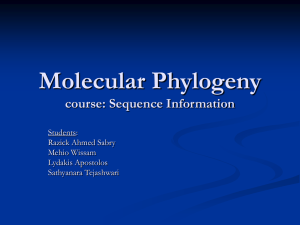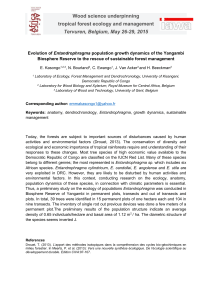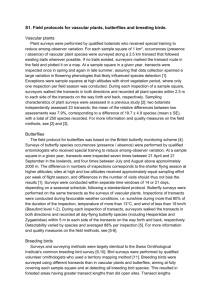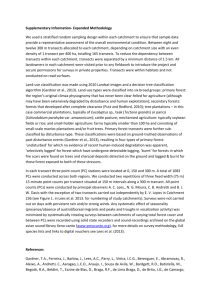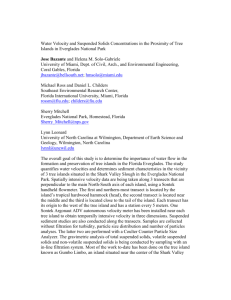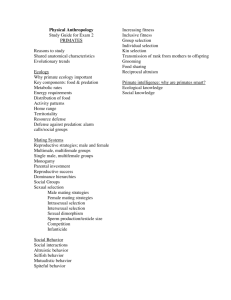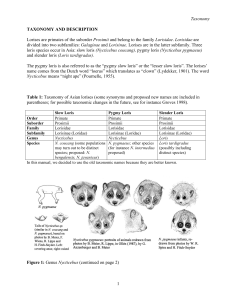RESEARCH COMMUNICATIONS
advertisement
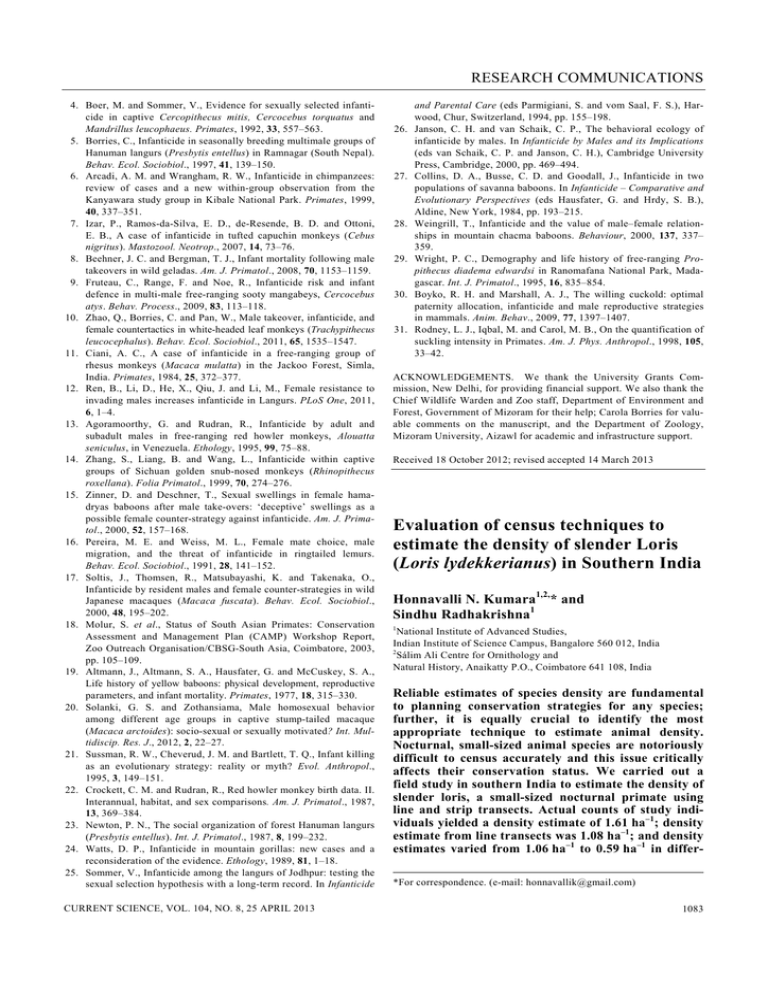
RESEARCH COMMUNICATIONS 4. Boer, M. and Sommer, V., Evidence for sexually selected infanticide in captive Cercopithecus mitis, Cercocebus torquatus and Mandrillus leucophaeus. Primates, 1992, 33, 557–563. 5. Borries, C., Infanticide in seasonally breeding multimale groups of Hanuman langurs (Presbytis entellus) in Ramnagar (South Nepal). Behav. Ecol. Sociobiol., 1997, 41, 139–150. 6. Arcadi, A. M. and Wrangham, R. W., Infanticide in chimpanzees: review of cases and a new within-group observation from the Kanyawara study group in Kibale National Park. Primates, 1999, 40, 337–351. 7. Izar, P., Ramos-da-Silva, E. D., de-Resende, B. D. and Ottoni, E. B., A case of infanticide in tufted capuchin monkeys (Cebus nigritus). Mastozool. Neotrop., 2007, 14, 73–76. 8. Beehner, J. C. and Bergman, T. J., Infant mortality following male takeovers in wild geladas. Am. J. Primatol., 2008, 70, 1153–1159. 9. Fruteau, C., Range, F. and Noe, R., Infanticide risk and infant defence in multi-male free-ranging sooty mangabeys, Cercocebus atys. Behav. Process., 2009, 83, 113–118. 10. Zhao, Q., Borries, C. and Pan, W., Male takeover, infanticide, and female countertactics in white-headed leaf monkeys (Trachypithecus leucocephalus). Behav. Ecol. Sociobiol., 2011, 65, 1535–1547. 11. Ciani, A. C., A case of infanticide in a free-ranging group of rhesus monkeys (Macaca mulatta) in the Jackoo Forest, Simla, India. Primates, 1984, 25, 372–377. 12. Ren, B., Li, D., He, X., Qiu, J. and Li, M., Female resistance to invading males increases infanticide in Langurs. PLoS One, 2011, 6, 1–4. 13. Agoramoorthy, G. and Rudran, R., Infanticide by adult and subadult males in free-ranging red howler monkeys, Alouatta seniculus, in Venezuela. Ethology, 1995, 99, 75–88. 14. Zhang, S., Liang, B. and Wang, L., Infanticide within captive groups of Sichuan golden snub-nosed monkeys (Rhinopithecus roxellana). Folia Primatol., 1999, 70, 274–276. 15. Zinner, D. and Deschner, T., Sexual swellings in female hamadryas baboons after male take-overs: ‘deceptive’ swellings as a possible female counter-strategy against infanticide. Am. J. Primatol., 2000, 52, 157–168. 16. Pereira, M. E. and Weiss, M. L., Female mate choice, male migration, and the threat of infanticide in ringtailed lemurs. Behav. Ecol. Sociobiol., 1991, 28, 141–152. 17. Soltis, J., Thomsen, R., Matsubayashi, K. and Takenaka, O., Infanticide by resident males and female counter-strategies in wild Japanese macaques (Macaca fuscata). Behav. Ecol. Sociobiol., 2000, 48, 195–202. 18. Molur, S. et al., Status of South Asian Primates: Conservation Assessment and Management Plan (CAMP) Workshop Report, Zoo Outreach Organisation/CBSG-South Asia, Coimbatore, 2003, pp. 105–109. 19. Altmann, J., Altmann, S. A., Hausfater, G. and McCuskey, S. A., Life history of yellow baboons: physical development, reproductive parameters, and infant mortality. Primates, 1977, 18, 315–330. 20. Solanki, G. S. and Zothansiama, Male homosexual behavior among different age groups in captive stump-tailed macaque (Macaca arctoides): socio-sexual or sexually motivated? Int. Multidiscip. Res. J., 2012, 2, 22–27. 21. Sussman, R. W., Cheverud, J. M. and Bartlett, T. Q., Infant killing as an evolutionary strategy: reality or myth? Evol. Anthropol., 1995, 3, 149–151. 22. Crockett, C. M. and Rudran, R., Red howler monkey birth data. II. Interannual, habitat, and sex comparisons. Am. J. Primatol., 1987, 13, 369–384. 23. Newton, P. N., The social organization of forest Hanuman langurs (Presbytis entellus). Int. J. Primatol., 1987, 8, 199–232. 24. Watts, D. P., Infanticide in mountain gorillas: new cases and a reconsideration of the evidence. Ethology, 1989, 81, 1–18. 25. Sommer, V., Infanticide among the langurs of Jodhpur: testing the sexual selection hypothesis with a long-term record. In Infanticide CURRENT SCIENCE, VOL. 104, NO. 8, 25 APRIL 2013 26. 27. 28. 29. 30. 31. and Parental Care (eds Parmigiani, S. and vom Saal, F. S.), Harwood, Chur, Switzerland, 1994, pp. 155–198. Janson, C. H. and van Schaik, C. P., The behavioral ecology of infanticide by males. In Infanticide by Males and its Implications (eds van Schaik, C. P. and Janson, C. H.), Cambridge University Press, Cambridge, 2000, pp. 469–494. Collins, D. A., Busse, C. D. and Goodall, J., Infanticide in two populations of savanna baboons. In Infanticide – Comparative and Evolutionary Perspectives (eds Hausfater, G. and Hrdy, S. B.), Aldine, New York, 1984, pp. 193–215. Weingrill, T., Infanticide and the value of male–female relationships in mountain chacma baboons. Behaviour, 2000, 137, 337– 359. Wright, P. C., Demography and life history of free-ranging Propithecus diadema edwardsi in Ranomafana National Park, Madagascar. Int. J. Primatol., 1995, 16, 835–854. Boyko, R. H. and Marshall, A. J., The willing cuckold: optimal paternity allocation, infanticide and male reproductive strategies in mammals. Anim. Behav., 2009, 77, 1397–1407. Rodney, L. J., Iqbal, M. and Carol, M. B., On the quantification of suckling intensity in Primates. Am. J. Phys. Anthropol., 1998, 105, 33–42. ACKNOWLEDGEMENTS. We thank the University Grants Commission, New Delhi, for providing financial support. We also thank the Chief Wildlife Warden and Zoo staff, Department of Environment and Forest, Government of Mizoram for their help; Carola Borries for valuable comments on the manuscript, and the Department of Zoology, Mizoram University, Aizawl for academic and infrastructure support. Received 18 October 2012; revised accepted 14 March 2013 Evaluation of census techniques to estimate the density of slender Loris (Loris lydekkerianus) in Southern India Honnavalli N. Kumara1,2,* and Sindhu Radhakrishna1 1 National Institute of Advanced Studies, Indian Institute of Science Campus, Bangalore 560 012, India 2 Sálim Ali Centre for Ornithology and Natural History, Anaikatty P.O., Coimbatore 641 108, India Reliable estimates of species density are fundamental to planning conservation strategies for any species; further, it is equally crucial to identify the most appropriate technique to estimate animal density. Nocturnal, small-sized animal species are notoriously difficult to census accurately and this issue critically affects their conservation status. We carried out a field study in southern India to estimate the density of slender loris, a small-sized nocturnal primate using line and strip transects. Actual counts of study individuals yielded a density estimate of 1.61 ha–1; density estimate from line transects was 1.08 ha–1; and density estimates varied from 1.06 ha–1 to 0.59 ha–1 in differ*For correspondence. (e-mail: honnavallik@gmail.com) 1083 RESEARCH COMMUNICATIONS ent fixed-width strip transects. We conclude that line and strip transects may typically underestimate densities of cryptic, nocturnal primates. Keywords: Density estimate, distance sampling, Loris lydekkerianus, nocturnal primate, strip transects. ACCURATE assessment of animal densities is essential for the conservation and management of any species; identification of the most appropriate method to estimate densities, however, is not an easy task1,2. This is more so in the case of nocturnal, solitary species, where density estimates are traditionally difficult to make. A wide variety of direct and indirect methods such as total count of study individuals, strip transects, line transects, capture–mark– recapture methods and observations of signs like faeces, nests and tracks, are available to assess and monitor species presence and abundance. Choice of the most appropriate method is usually dictated by the nature of the target species, environmental conditions and limitations of time and resources3. The grey slender loris Loris lydekkerianus Cabrera 1908 is a small-sized nocturnal prosimian primate that is endemic to Sri Lanka and southern India. Cryptic, solitary and arboreal, it is a model system that illustrates the difficulties of surveying nocturnal, solitary species. In this communication, we report the results of our study that examined the efficiencies of different methods in providing rapid and accurate density counts for the slender loris. Distribution surveys of the slender loris in India have employed the relative density method to address the population status of the species in terms of number of animals sighted per unit distance (animals/km)4–9. Although the relative density method is logistically easy to apply in the field in most of the field conditions, estimates obtained through this method are also less accurate10,11. The most accurate density estimates of species are obtained from complete counts of the study population. However, the time and effort that is required to achieve this for nocturnal, solitary species rule out the use of this method for rapid density counts. Cameratrapping is an important tool for assessing densities of cryptic species3; the cost of employing this method in the field makes it impracticable in India. Forest research permit regulations in India generally prohibit the use of invasive field methodologies. For this reason, it is not feasible to use capture–mark–recapture method to estimate densities of slender loris. Line transect sampling is perhaps the most commonly used technique to estimate population densities of diurnal and nocturnal primate species10,12. While line transects are considered more accurate, strip transects are easier to employ for rapid assessment of animal densities13. Hence, we evaluated the comparative efficiencies of line and strip transects in estimating absolute densities of slender loris populations. The accuracy of both these methods can only be assessed when the 1084 actual population size is reliably known14,15. We therefore first estimated the absolute density of a slender loris population based on complete counts of the study individuals, and then employed line and strip transects to estimate loris densities through these methods. The study was conducted in Tamil Nadu, southern India from October 2005 to June 2007. The study area lay roughly at 10′03″N and 78′08″E and was a mosaic of small private farms and tamarind and fruit orchards. We observed and followed study individuals from 18.00 h to 06.00 h using red cellophane paper-covered Petzl headlamps and individually identified them by distinctive physical markings on their bodies and locomotory idiosyncrasies16–18. We marked trees that were regularly used by the animals with flagging tape to identify tree pathways and home-range limits. Every month, we checked the study site to record the presence or absence of study individuals. Upon sighting a loris individual, we noted its identity and recorded the location using a hand-held GPS receiver (Garmin GPS 76). This search was repeated at least three to four times every month and at different times of the night to maximize the chances of sighting all individuals. We connected the outermost loris sighting locations to form the boundary of the study site and calculated the study area to be 7.2 ha (see Radhakrishna and Singh16 for more details on this methodology). We observed a total of 19 individuals in the study site; many individuals disappeared due to death or migration (Table 1). We recorded an average of 11.71 individuals per month; based on this figure, we estimated density of loris to be 1.61 ha–1 in the study area. We laid three transects of length 200, 350 and 400 m within the study area (Figure 1). Transects representatively sampled all vegetation of the area and the minimal distance between two transect lines was 100 m. We conducted standard line transect surveys19,20 five days every month, approximately, from November 2006 to May 2007. We walked all transects at different times of the Figure 1. Study area (7.2 ha) of open scrub land (10.05°N, 78.13°E) in Malapatti, Tamil Nadu, southern India with transects. CURRENT SCIENCE, VOL. 104, NO. 8, 25 APRIL 2013 RESEARCH COMMUNICATIONS Table 1. Age–sex class when last seen Status of study individuals from November 2006 to May 2007 Status at end of study November 2006 December 2006 January 2007 February 2007 March 2007 April 2007 May 2007 Adult females: PB, GH, MA, LA, VI, WI, HE All 7 present 6 √ HE × 6 √ HE × 5 √ HE, PB × 6 √ HE × 6 √ HE × 6 √ HE × 6 √ WI × Adult males: JU, CH, CL, JA All 4 present 2 √ CL, JA × 3 √ JA × 3 √ JA × 4√ 3 √ JU × 4√ 3 √ CH × Sub-adult females: KD, SU Both absent 2√ 2√ 2√ SU √ KD × 2 √ KD √ SU × Both × Juveniles and infants: TI, CO, ZI, ZA, BI, RI 4 present, 2 absent 2√4× 2√4× 2√4× 6× 6× 6× 4√2× Total 15 present, 4 absent 12 13 11 11 11 11 13 Table 2. Time/lunar phase category Evening Midnight Early morning Dark phase Light phase Density estimates from untruncated data of slender loris n Dˆ g (ha) Ŷ D̂ (ha) CV ( Dˆ ) (%) 95% CI (ha) 133 68 59 124 135 0.94 0.87 0.99 0.96 0.94 1.13 1.14 1.15 1.15 1.16 1.07 0.95 1.07 1.03 1.09 22.53 22.14 27.65 24.47 20.81 0.46–2.49 0.51–1.79 0.39–2.98 0.41–2.58 0.51–2.30 n, Number of detections; Dˆ g , Density of clusters; Yˆ , Mean cluster size; Dˆ , Density of individuals; CV ( Dˆ ), Per cent coefficient of variation; 95% CI, 95% confidence interval. night (evening: 19.00–22.00 h, midnight: 24.00–02.30 h, and early morning: 03.30–06.00 h) and during different phases of the moon (light phase and dark phase), covering a total of 66 km and accounting for 102 h of sampling effort. We estimated density of loris from line transects using the program DISTANCE (version 5.0)13,21. Several models of the probability density function (half normal, uniform, hazard, with cosine or polynomial adjustment terms) were applied to each set of data. The minimum number of detections (40) recommended for density estimation in DISTANCE was satisfied in all the categories. Based on comparisons of AIC values, the half-normal key function provided the best fit for loris data. Using the selected model in the program DISTANCE, the estimates of average probability of detection (p), density of cluster ( Dˆ g ), mean cluster size (Yˆ ) and animal density ( Dˆ ) were made (Table 2). There was no significant difference in loris density estimates for the different time categories (F = 0.059, df = 2, P > 0.942) or lunar phases (z = 0.2236, NS). However, the confidence interval remained very large in all the estimates. We pooled the data from different time categories of the night; loris density from these pooled and truncated (detections of distances more than 100 m from the transect lines were judged outliers) data was estimated to be 1.08 ha–1 (n = 255). Loris density estimates for 20, 40, 60 and 80 m width strip transects were found to be 1.06, 0.98, 0.74 and 0.59 ha–1 respectively (Table 3). Line transect density estimate was 33% lower than the actual count estimates, whereas strip transect CURRENT SCIENCE, VOL. 104, NO. 8, 25 APRIL 2013 density estimates were 34% (20 m), 40% (40 m), 54% (60 m) and 63% (80 m) lower than the actual count estimates. Strip transect density estimates were 1% (20 m), 10% (40 m), 32% (60 m) and 45% (80 m) lower than the line transect estimates. It is generally accepted12,22 that density estimates obtained using different techniques are reliable, if the difference between them is < 10%. Our study reveals, loris density estimates derived from line and strip transects are underestimates that fall outside the reliable range of values. However, the similar density values produced by line transects and 20 m and 40 m strip transects corroborate the premise that the behaviour of the study species, particularly its crypticity and the very mode of its detection, may be responsible for an underestimation of its number through transect sampling techniques. This argument is supported by the observation that infants carried by the mother were never detected during the course of line and strip transects in this study, although two sets of infant twins were present at the time in the study site. Interestingly, a study on the related Bengal slow loris Nycticebus bengalensis Lacepede 1800 observed that although loris densities based on distance sampling were similar in older plantations and primary forest habitats, encounter rates were lowest in primary forest, probably due to lower detection probabilities in these habitats23. Although our study demonstrates the underestimation problems associated with line and strip transects, we recommend their use to estimate densities of nocturnal species, for the underestimations are not very high, and the 1085 RESEARCH COMMUNICATIONS Table 3. Density estimates from fixed-width strip transects Density (SD) 40 m Overall Time category Lunar phase category 120 m 160 m Evening Midnight Morning 1.06 (± 0.24) 1.13 (± 0.29) 1.00 (± 0.16) 0.97 (± 0.42) 0.97 (± 0.13) 0.99 (± 0.12) 0.94 (± 0.20) 0.94 (± 0.25) 0.73 (± 0.11) 0.75 (± 0.07) 0.76 (± 0.14) 0.69 (± 0.17) 0.59 (± 0.80) 0.59 (± 0.05) 0.65 (± 0.14) 0.54 (± 0.10) Light Dark 1.28 (± 0.41) 0.95 (± 0.35) 1.04 (± 0.14) 0.93 (± 0.17) 0.80 (± 0.03) 0.71 (± 0.15) 0.62 (± 0.04) 0.58 (± 0.10) two methods offer a relatively easy and standardized way to compare densities across different sites. Density estimates from 20 m strip transects and line transects are similar. Line transect is generally not recommended for a rapid assessment in the thick rain forest, as detections will be poor due to vegetation. However, line transect may be used for a single species, where the species is detected through light/torch or specific call. 1. Marshall, A. R., Lovett, J. C. and White, P. C. L., Selection of line-transect methods for estimating the density of group-living animals: lessons from the primates. Am. J. Primatol., 2008, 70, 452–462. 2. Wilson, G. J. and Delahay, R. J., A review of methods to estimate the abundance of terrestrial carnivores using field signs and observation. Wildl. Res., 2001, 28, 151–164. 3. Silveiraa, L., Jácomoa, A. T. A., Alexandre, J. and Diniz-Filho, F., Camera trap, line transect census and track surveys: a comparative evaluation. Biol. Conserv., 2003, 114, 351–355. 4. Kumar, M. A., Singh, M., Srivastava, S., Udhayan, A., Kumara, H. N. and Sharma, A. K., Distribution and management of wild mammals in Indira Gandhi Wildlife Sanctuary, Tamil Nadu, India. J. Bombay Nat. Hist. Soc., 2002, 99, 184–210. 5. Kumara, H. N., An ecological assessment of mammals in nonsanctuary areas of Karnataka. Ph D thesis, University of Mysore, 2005. 6. Kumara, H. N., Impact of local hunting on abundance of large mammals in three protected areas of the Western Ghats, Karnataka. Final Technical Report, submitted to Rufford Small Grants, UK, 2007. 7. Kumara, H. N., Singh, M. and Kumar, S., Distribution, habitat correlates and conservation of slender loris Loris lydekkerianus in Karnataka, India. Int. J. Primatol, 2006, 27, 941–969. 8. Singh, M., Lindburg, D. G., Udhayan, A., Kumar, M. A. and Kumara, H. N., Status survey of slender loris Loris tardigradus lydekkerianus in Dindigul, Tamil Nadu, India. Oryx, 1999, 33, 31–37. 9. Singh, M., Kumar, M. A., Kumara, H. N. and Mohnot, S. M., Distribution and conservation of slender lorises (Loris tardigradus lydekkerianus) in southern Andhra Pradesh, South India. Int. J. Primatol., 2000, 21, 721–730. 10. Sterling, E. J. and Ramaroson, M. G., Rapid assessment of the primate fauna of the eastern slopes of the Réserve Naturelle Intégrale d’Andringitra. Fieldiana, Zool. New Ser., 1996, 85, 293– 303. 11. Ruette, S., Stahl, P. and Albaret, M., Applying distance-sampling methods to spotlight counts of red foxes. J. Appl. Ecol., 2003, 40, 32–43. 1086 80 m 12. Whitesides, G. H., Oates, J. F., Green, M. S. and Kluberdanz, R. P., Estimating primate densities from transects in a West African rain forest: a comparison of techniques. J. Anim. Ecol., 1988, 57, 345–367. 13. Buckland, S. T., Anderson, D. R., Burnham, K. P. and Laake, J. L., Distance Sampling, Chapman and Hall, London, 1993. 14. Defler, T. R. and Pintor, D., Censusing primates by transect in a forest of known primate density. Int. J. Primatol., 1985, 6, 243– 259. 15. Verner, J., Assessment of counting techniques. Curr. Ornithol., 1985, 2, 247–302. 16. Radhakrishna, S. and Singh, M., Home range and ranging pattern in the slender loris (Loris tardigradus lydekkerianus). Primates, 2002, 43, 237–248. 17. Radhakrishna, S. and Singh, M., Activity schedule and habitat use of slender loris (Loris tardigradus lydekkerianus). J. Bombay Nat. Hist. Soc., 2002, 99, 400–407. 18. Nekaris, K. A. I., Activity budget and positional behavior of the Mysore slender loris: implications for slow climbing locomotion. Folia Primatol., 2001, 72, 228–241. 19. Anderson, D. R., Laake, J. L., Crain, B. R. and Burnham, K. P., Guidelines for the transect sampling of biological populations. J. Wildl. Manage., 1979, 43, 70–78. 20. Buckland, S. T., Anderson, D. R., Burnham, K. P., Laake, J. L., Borchers, D. L. and Thomas, L., Introduction to Distance Sampling: Estimating Abundance of Biological Populations, Oxford University Press, Oxford, 2001. 21. Laake, J. L., Buckland, S. T., Anderson, D. R. and Burnham, K. P., DISTANCE: User’s Guide, V 2.1. Colorado Co-operative Fish and Wildlife Research Unit, Colorado State University, Fort Collins, CO, USA, 1994. 22. Hassel-Finnegan, H. M., Borries, C., Larney, E., Umponjan, M. and Koenig, A., How reliable are density estimates for diurnal primates? Int. J. Primatol., 2008, 29, 1175–1187. 23. Pliosungnoen, M., Gale, G. and Savini, T., Density and microhabitat use of Bengal slow loris in primary forest and non-native plantation forest. Am. J. Primatol., 2010, 72, 1108–1117. ACKNOWLEDGEMENTS. This study was supported by the American Society of Primatologists, USA and Department of Science and Technology, Government of India. We thank the Forest Department of Tamil Nadu, particularly Dr Sukhdev Thakur, PCCF and CWW, Chennai and Mr S. Balaji, DFO, Madurai for research permits to conduct this study and for their help with field logistics. We thank S. Ramkumar and his family, R. Sasi, S. Sunil, Dr Anindya Sinha, Dr Ajith Kumar, Hari Sridhar and Shanthala Kumar for their help and support during the study. Received 10 September 2012; revised accepted 5 March 2013 CURRENT SCIENCE, VOL. 104, NO. 8, 25 APRIL 2013
